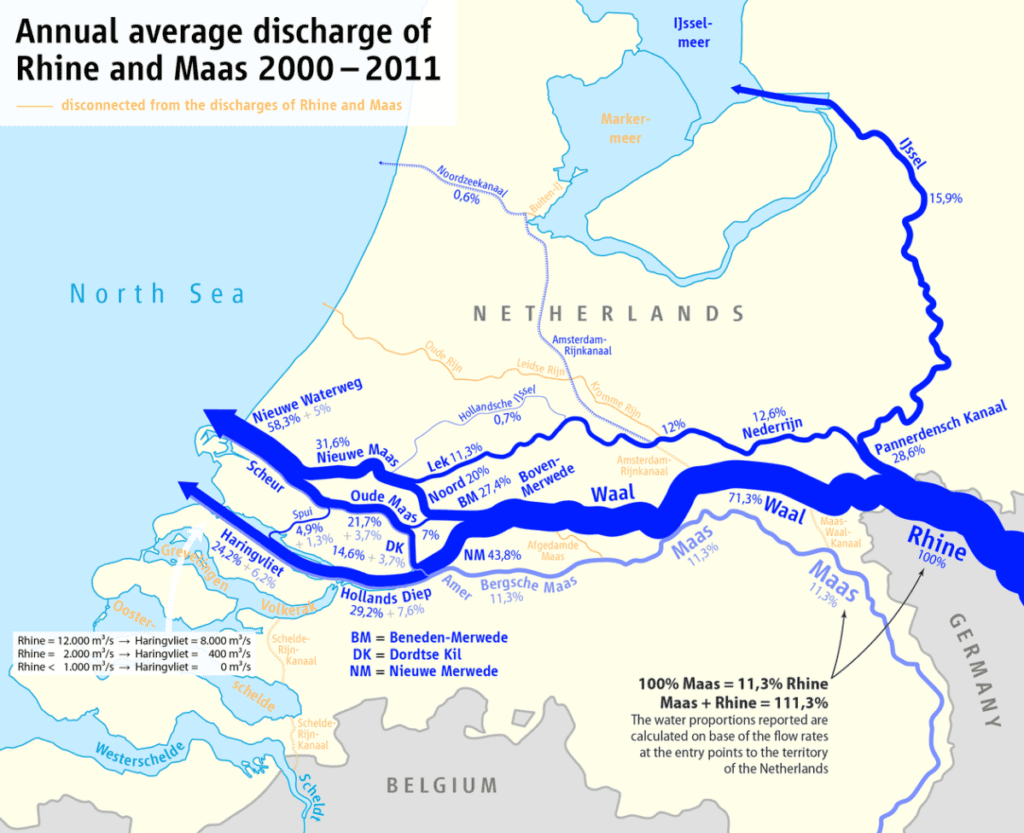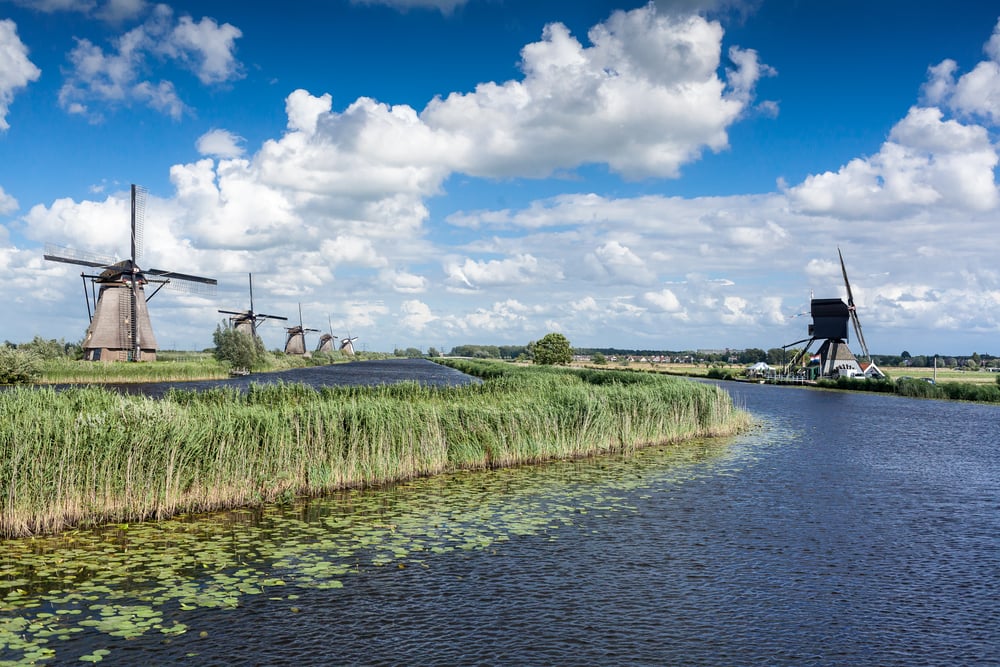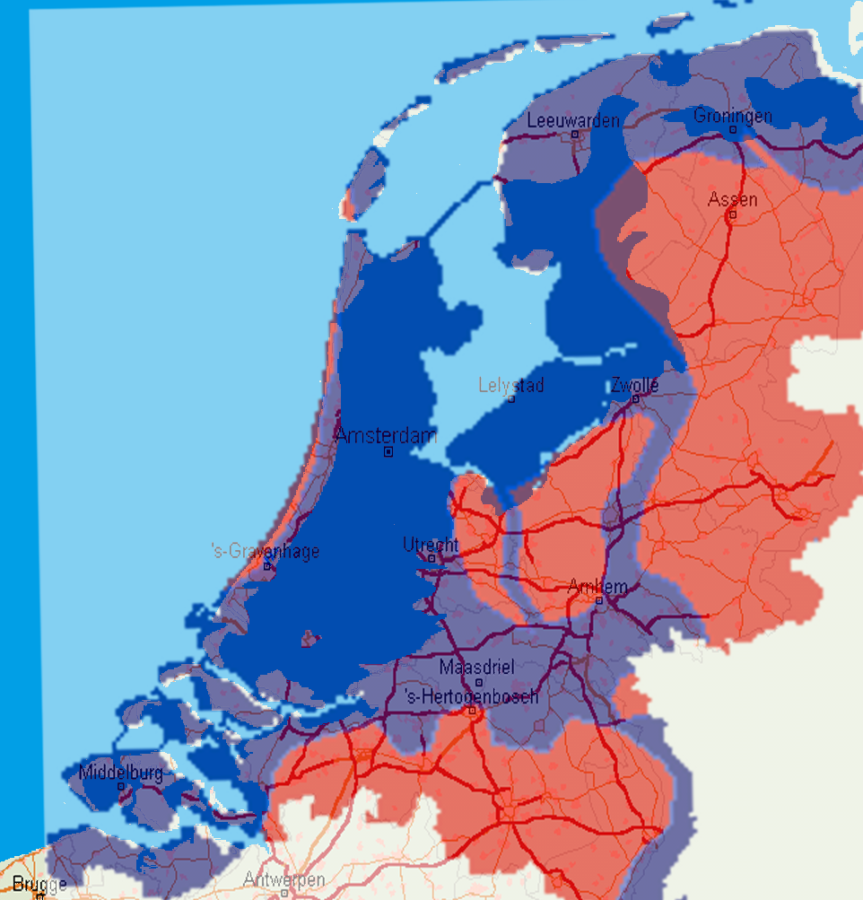If you’ve ever found yourself wondering how on earth the Netherlands is so flat, you’re not alone.
When I take a train from Belgium or Germany back into the Netherlands, I know I’ve crossed the border when the horizon suddenly begins to stretch out in front of me, completely undisturbed by hills or mountains.
Coming from a mountainous country, the very sight of it gets the cogs in my brain turning — how is the Netherlands so flat!?
How did the Netherlands become so flat?
It turns out that a combination of geography and land reclamation from the sea is the key to explaining the ruler-straight horizon. Let’s take a look at how each of these works.
Dutch geography is naturally flat land
Most of the Netherlands consists of naturally flat, low-lying plains — hence the Nether-lands. This is to do with it being the drainage point of western Europe.
Four major rivers (the Rhine, the Meuse, the Scheldt, and the Eems) flow into the Netherlands and drain into the Wadden and North Seas via the Dutch coastline.

How the Dutch reclaimed land from the sea
A whopping 17% of land in the Netherlands used to be under the water! Stealing this land back to build entire cities is one of the many reasons the Dutch are renowned for their engineering and water management skills. It’s also why much of Holland is so flat.
How exactly the Dutch achieved this is truly impressive. First, dikes were built to section off strips of submerged land and to prevent more seawater from flooding in. These areas were called polders.
READ MORE | Why the Netherlands isn’t under water (VIDEO INSIDE)
The seawater was then pumped out of the polders using windmills, and plants were used to stabilize the ground. Polder ground is rich in clay, fertile, and yes, very, very flat.
The following video has some great animations to show you this process:
Is the Netherlands below sea level?
You’ll wet your pants (thi-hi) if you think about this too much, but yes, 27% of the country lies below sea level (meaning about 10% of the Netherlands was already below sea level before the land reclamation).
READ MORE | Dutch Quirk #124: Not care about the fact that they’re living below sea level
A baffling 21% of the 17 million Netherlanders reside quite blissfully in what used to be seafloor. This includes major cities like Amsterdam, Rotterdam, and Delft. The lowest point is 6.7 metres below sea level!
The Dutch dike system protects the Netherlands from flooding and other natural disasters. The Delta Works in the southwest of the country is one of the largest systems of dikes, locks, and storm barriers built to protect the country.
When dikes fail: Watersnoodramp
The flooding of 1953 was the largest flooding disaster in the Netherlands on record and is known as the Watersnoodramp.
It was caused by a storm from the North Sea and killed over 2,100 people. Immense damage was caused to areas in the provinces of South Holland, Zeeland, and North Brabant.
The three-border region of Vaals, where the Netherlands meets Germany and Belgium, is the highest point of the country — but it’s still only 323 meters high. That doesn’t stand up to places like the Swiss Alps, which are up to 4,634 metres above sea level!
Is the Netherlands sinking?
You may have heard that much of the Netherlands is built on sinking ground, and unfortunately, this is true.
The continuous drainage that is required to keep parts of the country dry — now done by massive water pumps rather than windmills — is causing the land to sink up to seven millimetres per year.
Climate change is also contributing to the nation’s downward drift. As the summers become warmer, the clay-rich land dries faster and thus sinks faster.

This can cause huge problems for Dutch infrastructures, like cracking foundations, destabilized roads, sinkholes, and an increased risk of flooding.
A few old canals and quays in Amsterdam have already collapsed. Many Dutch cities are reinforced with underground poles to try to fight this. Older houses were built on wooden piling, which is now rotting, often costing millions of euros to replace.
A report by the PBL, the Dutch Environmental Assessment Agency, predicts around €5.2 billion will be needed to restore weak foundations by 2050. Ouch!
How is the Netherlands preparing for rising sea levels?
Unlike some politicians with *cough* bleached cats for toupees *cough*, the Dutch government does not ignore climate change, nor do they plan on building any walls.
READ MORE | The Dutch built cities on sinking land: how will this fare with climate change?
“We can’t just keep building higher levees, because we will end up living behind 10-metre walls,” senior government advisor Harold van Waveren told the New York Times.
Instead, the Dutch are building inland reservoirs to catch floodwaters in a project called Room for the Water. In this way, the Dutch hope to continue to do what they have always done best — that is, to live with water rather than fight against it.
But the Room for the Water project has received criticism too. The area of Noordwaard, once a thriving farm region in the southwest of the Netherlands, is now only a watery marshland after it was designated as a flood-catchment zone for the project.
Homes were demolished and people displaced, and some fear that with rising sea levels, this will be the fate of many Dutch areas in the future. Concerns have arisen over how sustainable the Room for the Water strategy really is.
Now you know: the Netherlands is flat both because of natural geography and because of land reclamation. And still fighting the natural forces of the world, the nation keeps pumping a lot of money, brainpower, and water into keeping its cities dry.
Are you impressed by amazing Dutch innovation? Is the Netherlands doing enough to save itself from climate change? Tell us in the comments below.


I think the nature will decide what to do
Leave your political comments out of it.
I believe in “Climate change”. It happens every ~150,000 years and ends in an ice age.
Reference the Vostok Ice Core sample data. *cough* *cough*